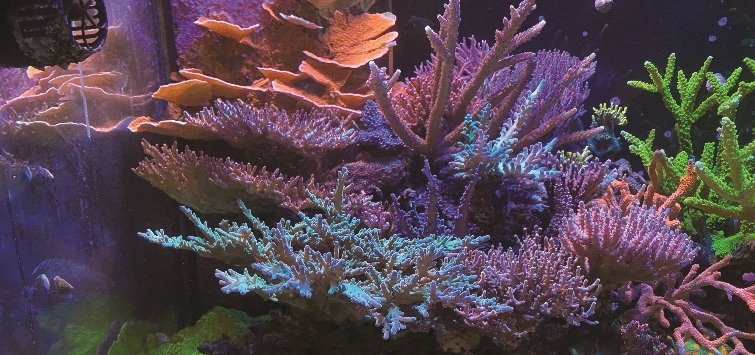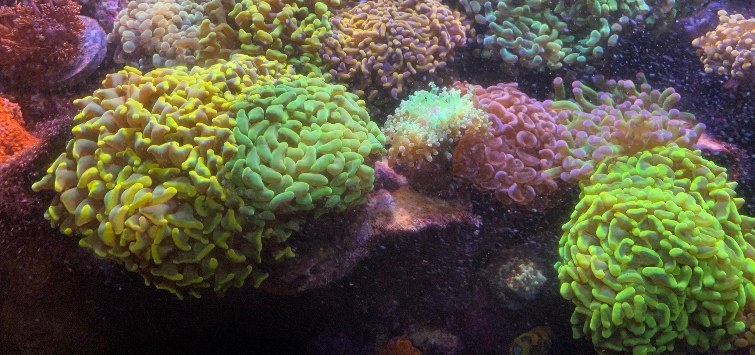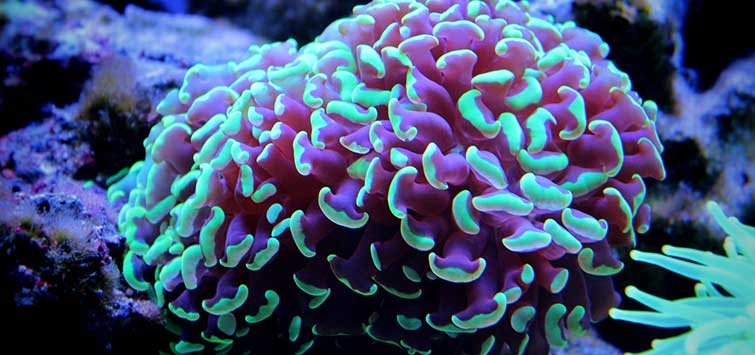Optimizing Coral Growth and Color
Author: Michael Paletta
When setting up or running a reef tank, the goal is to optimize the conditions for the system’s inhabitants to grow and flourish; this is the definition of a successful aquarium. As our knowledge about the hobby has increased, success in reefkeeping is much easier to achieve than ever before. Interestingly, as our success has increased, so too has our understanding of the essential factors for success, which factors improve coral growth and color dramatically, and which things only improve them incrementally.
We usually talk about “limiting factors” when we discuss the topic of coral growing and color, which means essentially anything that constrains an organism’s size or health and slows or stops it from growing. The idea is to overcome these limiting factors to allow for our corals to reach their full potential.
For the sake of this discussion, I will assume that your corals are being housed in tanks with good water quality, proper lighting, and no fish or other invertebrates that will harm them. Absent those major limiting factors, what are some of the other limiting factors in our tanks that reduce or inhibit optimal growth and coloration in our corals?
Tankspace
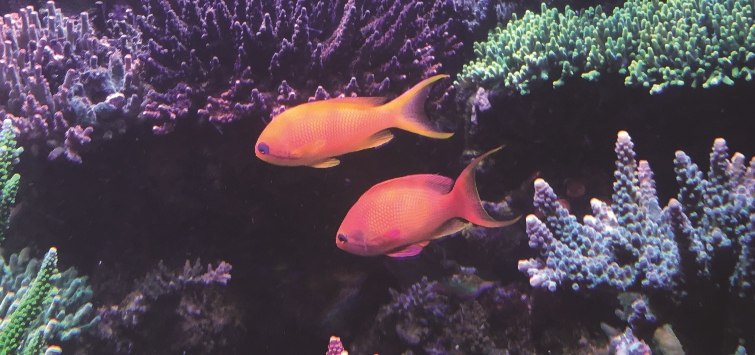
On a natural reef, every square millimeter of space is utilized, and every invertebrate has a niche within the reef where it thrives. Over the millennia that corals have been around, they have evolved to utilize and fight for space. As a result, they have developed lots of mechanisms to capture this territory, many of which are chemical in nature.
On a reef, the dilution and subsequent breakdown of these chemicals occurs relatively quickly. But in the confines of our closed systems, these chemicals can not only maim or kill neighboring corals, but they can also harm distant inhabitants in the tank as well. For this reason, space is one of the main limiting factors that keep our corals from reaching their potential.
In addition to chemical means, some corals have developed the ability to overgrow their neighbors. Tabling Acropora corals and plating Montipora corals are two types that best utilize this strategy. Interestingly, when these corals engage in a chemical battle with neighboring corals they often lose, but when it comes to quickly overgrowing a rival, they are hard to beat.
For these reasons, adequate space needs to be provided for our corals to reach their optimal condition. But when you’re setting up a tank, it may be difficult to visualize how big a coral may eventually grow before it starts attacking its neighbors—especially these days, when most corals start out as small frags. Initially, the tank looks almost bare.
To me, it is akin to when we start our gardens in the spring and place the seeds or small seedlings in spots throughout the bed and it looks empty, so we often overplant at this stage. But come July and August the bed is full of plants, and if they were planted too close to one another they won’t produce the yield they would if we had planned better.
I know I have done this in filling out my own new reef tank. But I did so knowing that, when I placed so many frags in the tank, some would need to be removed once I could see how they grew and their full coloration developed. Even though they were placed with some empty space around them, I knew space would be limiting for them down the line and some would need to be removed.
Coral Feeding and Nutrition
Another limiting factor, and one about which there is still much debate, is the feeding of corals. In my opinion, the understanding and implementation of coral feeding and nutrition is still one of the least understood aspects of the hobby. I still frequently read how just relying on excess food and fish waste to feed corals is more than enough. While it may be enough along with adequate light to provide for some growth and maintain their health, to me it is a limiting factor for optimizing their growth and ability to have enough energy to spawn.
That latter aspect has been proven in the work that UK public aquarium director Jamie Craggs, PhD (Natural History Museum of London, Horniman Museum and Gardens) has been doing to get corals to spawn on a regular basis. When you look at a coral’s structure, the majority of the animal is devoted to feeding. If an animal has that much of its body designed to capture food, it follows that feeding must be important.
I now know of at least six individuals who have gotten their corals to spawn in their tanks, and all of them feed their corals in one way or another on a regular controlled basis, rather than just relying on excess fish food and wastes.
I have been experimenting with different foods and feeding regimens for the past year and have seen the effects that regular small feedings can have on coral growth. When I started these experiments, I was skeptical that coral feeding would make much of a difference, but I now know it does. I plan on using two new methodologies in the upcoming months that should have an impact beyond what I’m already doing, and I look forward to sharing the results.
I should also point out that due to the work of Dana Riddle, aquatics professional and author of The Captive Reef: A Concise Guide to Reef Aquaria in the Home (1996, Energy Savers Unlimited, Inc.), it is clear that corals are more generalized feeders than we initially thought. In his work, he found that most of the SPS corals that we keep not only feed on zooplankton of various sizes, but also feed on phytoplankton, bacteria, amino acids, and just about anything that they can capture. So, it may not be as much of an issue as we once thought to find a food that our corals will eat. However, it should also be noted that feeding any of these items in excess can lead to a rapid increase in nutrients. Care should be taken not to overfeed.
Nutrient Levels
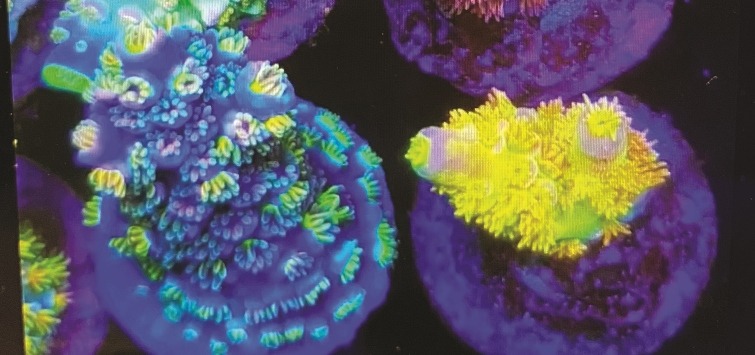
Like feeding, nutrient levels—nitrate and phosphate—are limiting factors, and it also stirs some debate when their proper levels are discussed. For much of the first two decades of this hobby, the goal was to have them both at zero or as close to zero as possible, due to the desire to keep algae from dominating the tank and overwhelming the corals. However, over time we have come to realize that corals require these compounds to meet their nutritional needs in order to thrive.
Unfortunately, there are no precise numbers that I can provide that will produce perfect-colored, fast-growing healthy corals, because there are more to their numbers than just their being at X and Y levels. Lighting intensity and spectrum, bioload, and filtration, to name just some of the simple factors, all impact how important nitrate and phosphate are in your setup.
In my discussions with many successful reefers, I have found numbers up to 20 mg/L for nitrates and up to 0.1 mg/L for phosphate, and in all of these tanks the corals were colorful and thriving. However, I should note that in none of the tanks were both of these values at 0, and in my opinion the tanks with the fastest-growing, most colorful corals all had low but very detectable levels of both.
In my own experiments I have looked at not only the levels, but also the ratio between them to try and minimize their being limiting factors. As with everything, pushing past the limiting factors takes time before seeing any impact, and this is the case with these compounds as well.
Trace elements and additives have been thought to be limiting factors for a long time in the hobby, but unfortunately until recently it was difficult to determine exactly how much was too little, and if there was too much, it was often deleterious. However, over the past five years the widespread use of inductively coupled plasma (ICP) testing has enabled us to determine what the optimal levels of many trace elements should be, and individual trace elements have also come onto the market.
This is important in that, until ICP testing and individual trace elements became available, we could at best guess which trace elements were lacking and when we wanted to add them. We had to add them in a mix, rather than individually. So, if one element was lacking but the others were adequate or, worse, high, they were all added in a mix. There was no way to tell if the levels were wrong until corals began to die. It was often difficult to determine how much of an individual trace element was required, and how often it needed to be added to optimize its consumption.
Fortunately, there are now sources on the internet that can provide a calculator for how much and how often most of the trace elements need to be added. Based on what I have seen, when trace elements are added properly, they no longer are a limiting factor for our corals, and at the proper levels they can significantly enhance their coloration.
I should also point out that trace elements seem to be most important in this regard when all the other factors are optimal. If all the other things are not right, then adding trace elements will not overcome those shortcomings.
Water Flow
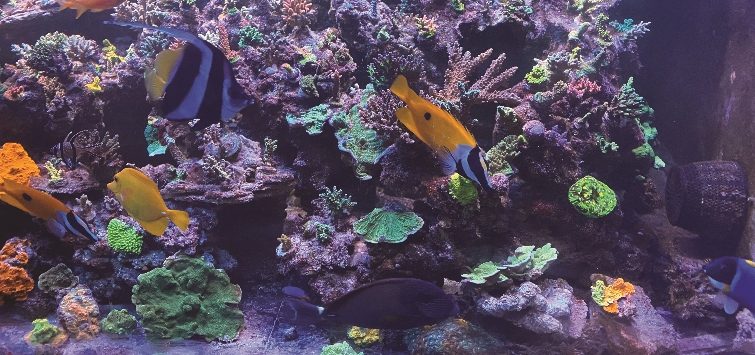
One of the other factors affecting coral growth and coloration that I have found to often be overlooked is water flow. Flow is important, as corals have no means for removing waste from their surfaces or for obtaining oxygen or nutrients aside from relying on water movement to take care of this.
How important flow is to the health of a tank can be demonstrated by what I have learned the hard way. During the past couple of years, I have had my tank undergo a periodic blackout period of three to four days to help eradicate cyanobacteria and dinoflagellates. And when the lights were turned back on the corals all looked fine, as though nothing had happened.
Then, due to a circuit breaker being flipped, the circuit to which the circulation pumps on my tank were connected shut off for 12 hours while I was away. Immediately upon switching it back on and activating the pumps, it was readily apparent that the corals were stressed due to this short-term reduced flow. Seeing this reaction, it was readily apparent how important having adequate flow is in a closed system.
In this regard, it is my opinion than flow is only too strong if it is damaging the corals or keeping them from being mounted. Otherwise, both from my experience in my tanks and from diving on coral reefs, flow should be as strong as possible on and around the corals. In my own setups and successful tanks that I have seen, in terms of gallons per hour, this flow needs to be at least 50 times the volume of the tank, or even better, 100 times or more.
And it should also be noted that over time, as the corals grow, it may be beneficial to increase the flow because, while the corals grow and get larger, they can significantly create more drag on the flow, thus reducing it. If this is not done, detritus can accumulate near their bases or in the colonies themselves, resulting in dead spots that can kill the coral.
Research and Knowledge
Lastly, one huge factor in coral growing and color, at least in my opinion, is knowing the conditions in which the coral you have chosen will do best. Not all corals do best in the same conditions, as some are from deep water and prefer less light, some come from stronger current and prefer more water motion, some need to be fed directly, and yet others don’t tolerate being anywhere near other corals.If you don’t know what conditions are optimal for a coral you have chosen, the chances for success with it are greatly reduced. Even though many of the corals we are now adding to our tanks are maricultured or aquacultured, they are all still not from the exact same conditions. Each mariculture facility is different in that some are deep while others are in shallow water. Similarly, each aquaculture facility is different as well, and the corals being raised in them differ in terms of their optimal conditions.
If we don’t look into where our corals came from and try to provide the same conditions, we should not be surprised when our corals do not look like the ones we see online, at shows, or in dealers’ tanks. I have learned to always ask and observe where a coral is in a tank where it is showing its best. I have also learned to ask what it does not like, or if it does not tolerate the presence of something—for example, some SPS corals do not readily tolerate the presence of some soft corals.
I learned to always ask that last question due to an expensive lesson I learned when I purchased a selection of bubble-tip anemones at a show, all from the same dealer. Since they were all from the same dealer, I assumed that he grew them together and there would be no problems.
Unfortunately, as I later learned, many anemones produce chemicals that are toxic to their cousins. They do so to keep from having to battle them directly. While this works well on a wild reef to have them keep their distance, in a reef tank it meant that over time the chemicals in the water produced by a large robust rainbow bubble-tip killed the weaker, more expensive black widow anemone housed with it. This seems to be an even bigger issue with the more expensive lemon drop and sunburst anemones.
As a result of these and other teachable moments over the years, I have learned to try and not have my lack of research and knowledge become its own limiting factor for the corals in my tanks. As with much of this hobby, it is all a work in progress.

.png?h=595&iar=0&w=2781&hash=5FD5E69473BCC22199FBFA2FB71B6033)
